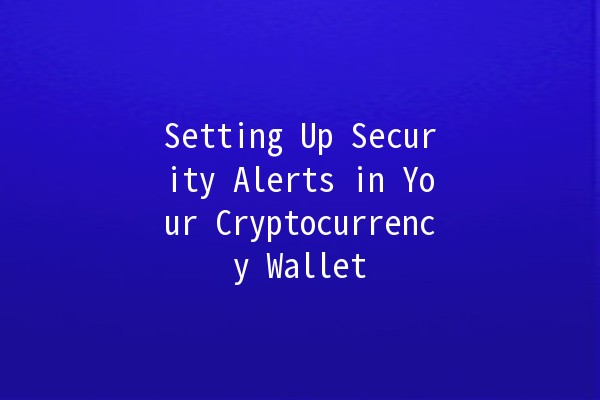




In the everevolving world of cryptocurrencies, securing your assets is of paramount importance. With the rise of digital currencies, cyber threats have also surged, and leaving your investments unguarded can lead to irreversible losses. One of the most effective ways to protect your cryptocurrency wallet is by setting up security alerts. These alerts act as a trusty shield, notifying you of suspicious activities and unauthorized access attempts. In this article, we will explore practical tips and techniques for setting up security alerts in your cryptocurrency wallet, ensuring your assets remain safe and secure.

Cryptocurrency wallets, whether softwarebased or hardwarebased, are prime targets for hackers. When security alerts are set up, you can receive immediate notifications about:
Unusual login attempts
Large transactions
Changes to wallet settings
Access from unrecognized devices
Implementing security alerts not only keeps you informed but also allows you to react promptly to potential threats, making it more difficult for malicious actors to compromise your accounts.
Here are five practical tips to enhance the security of your cryptocurrency wallet through alerts:
Before you can set up alerts, you need to choose a wallet that allows for customizable security features. Look for wallet providers that prioritize security and offer builtin alert functionalities. Some popular options include:
Exodus: Known for its userfriendly interface and robust security features, allowing alert settings.
Ledger Nano X: A hardware wallet that provides enhanced security with options for alerts through connected apps.
Coinbase: A widelyused exchange that offers comprehensive alert systems for unusual activities.
Application Example: If you choose Coinbase, you can enable alerts for all transactions within your wallet, allowing you to stay notified of any outgoing transactions.
Twofactor authentication is an essential security measure that adds an extra layer of protection by requiring a second piece of information to verify your identity during login attempts. Many wallet providers offer 2FA integration.
Google Authenticator and Authy are popular choices that generate temporary codes for verification.
Application Example: By enabling 2FA on your wallet, every time you log in, you'll receive a unique code on your mobile device. This code must be entered along with your password, enhancing security and ensuring you are notified of any unrecognized access attempts.
Most wallet services allow you to set up customizable transaction alerts. These notifications inform you of any incoming or outgoing transactions, ensuring you are always aware of your wallet activity.
Configure alerts for transactions exceeding a specific amount, so you can instantly react to any significant changes in your finances.
Application Example: If you set a transaction limit of $500, every time a transaction above this amount occurs, you will receive an instant notification, allowing you to verify its legitimacy immediately.
Regularly monitor the devices that have access to your wallet. Many wallet providers have features that allow you to view the login history and devices that have accessed your account.
Check for unknown devices and logins, ensuring you can take preventive measures if needed.
Application Example: If you notice a login from a device you don’t recognize, swiftly change your password and alert your wallet provider about potential unauthorized access.
Take full advantage of the customization features for alerts provided by your wallet. You can usually select the types of events that trigger notifications, such as:
Logins from new devices
Changes to account settings
Largescale withdrawals or transactions
Application Example: If you prefer to be alerted for any setting changes, enable notifications for modifications, so you can take action immediately if unauthorized changes are detected.
Before choosing a wallet provider, research their security history, user reviews, and the types of encryption used. Ensure they offer features like 2FA and customizable alerts.
While security alerts greatly enhance the protection of your cryptocurrency wallet, no system is entirely foolproof. It is essential to combine them with other security measures, such as strong passwords and regular monitoring.
If you receive a suspicious alert, immediately change your password and enable any additional security features provided by your wallet. Confirm the alert with your wallet provider and ensure there are no unauthorized transactions.
Yes, you can use multiple wallets simultaneously. Ensure that each wallet is configured with its own set of alerts. Different wallet providers may offer unique alert options, so familiarize yourself with each platform.
Generally, hardware wallets are considered safer because they store your assets offline, reducing exposure to online threats. However, they must be set up correctly to enable alerts, and regular firmware updates are necessary.
It is advisable to check your wallet activity regularly, at least once a week. Monitor any transaction alerts and ensure that all loggedin devices are familiar to you. Frequent checks can help identify any suspicious activity early.
With the digital landscape becoming increasingly perilous for cryptocurrencies, implementing security alerts in your cryptocurrency wallet is a must. By putting in place practical safety measures, you proactively safeguard your investments. Prioritize your wallet choice, enable twofactor authentication, set transaction alerts, monitor device accesses, and customize your alert preferences. Each of these steps enhances your security posture while giving you peace of mind that your digital assets are protected. As you navigate through the interconnected web of cryptocurrency, staying informed and vigilant will serve you well in your financial journey.